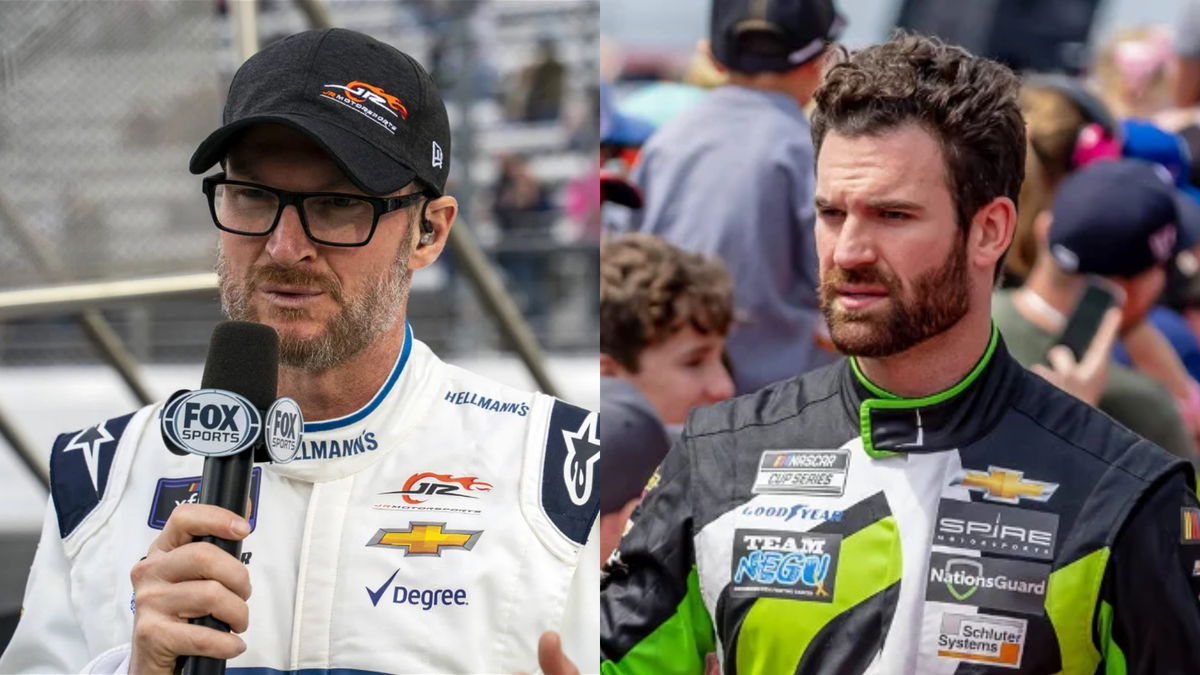
Imago
Image Credits: Imago

Imago
Image Credits: Imago
“The seat is that driver’s office,” a senior NASCAR official said in 2020. As the driver strives to be at his peak performance for three or four hours, ensuring safety is entirely the higher-ups’ responsibility. So when Corey LaJoie‘s No. 7 Chevy took a ride in mid-space on Lap 136 and slid through the straightaway at Michigan International Speedway for 15 seconds, the scene concerned most fans and officials looking. However, veteran driver Dale Earnhardt Jr. was unfazed.
Watch What’s Trending Now!
As a high-impact sport, NASCAR witnesses chilling crashes as a part of its curriculum. Nevertheless, the sanctioning body has taken a big call after LaJoie’s scary wreck in Michigan.
Bob Pockrass informed about the safety measure as NASCAR heads to Daytona: “After evaluating LaJoie flip, NASCAR mandating Right Side Rear Window Air Deflector this weekend. This component increases liftoff speed of the car in the early part of the spin. NASCAR says parts have been wind tunnel tested and quantified. Will be just like one on left side.”
ADVERTISEMENT
After evaluating LaJoie flip, NASCAR mandating Right Side Rear Window Air Deflector this weekend. This component increases liftoff speed of the car in the early part of the spin. NASCAR says parts have been wind tunnel tested and quantified. Will be just like one on left side.
— Bob Pockrass (@bobpockrass) August 21, 2024
As for Junior, he had emphasized earlier how flips are not that scary as opposed to hitting a wall at 150 mph. “Denny Hamlin said on his podcast…he’d rather flip than hit the wall in this car. That makes perfect sense to me. Yes, flips can get violent…people have been killed in cars that get airborne. But the potential for that violent G forces and impact that you tend to feel in wall contact…the potential is a little bit less I think, in a flip,” he said on the Dale Jr Download podcast.
The veteran further added: “As disorienting and unpleasant as getting airborne is…It’s scary to anybody who’s never been in a race car…Heading toward a wall, knowing you are going to hit it at 150 mph is more terrifying and always going to be.”
ADVERTISEMENT
LaJoie, on the other hand, was as confused as were we. However, he also guessed the bizarre incident might have got something to do with “the optional air jack system that NASCAR allowed teams to install at Michigan to aid cars with flat tires stuck on the race track”. Notably, the driver experienced a G-force of around 30Gs. Dale Earnhardt, on the other hand, had experienced around 45 and 50 Gs—40 to 50 times the force of gravity—much lesser than Elliott Sadler’s 2o10 86Gs Pocono crash.
While Sadler miraculously walked away with minor injuries to his right shoulder and collarbone, The Intimidator suffered a ring fracture at the base of his skull. Unfortunately, it all comes down to the presence of safety measures, or the lack thereof back then, which gave such strikingly different outcomes.
ADVERTISEMENT
Hence, contrary to NASCAR focusing its attention on airborne crashes now, it has poured more importance on crucial danger zones of the sport.
The risk factor is way less
If Dale Earnhardt was alive now, he’d probably grumble about the countless safety measures NASCAR has adopted. “If you’re not a race driver, stay the hell home. Don’t come here and grumble about going too fast. Get the hell out of the race car if you’ve got feathers on your legs and b*tt. Put a kerosene rag around your ankles so the ants won’t climb up and eat that candy a**,” he had once said when asked about stock cars going too fast.
ADVERTISEMENT
But yet, when both Denny Hamlin and Dale Earnhardt Jr. dialed down the Michigan wreck, they were right. We are no longer at the cusp of the 21st century when NASCAR witnessed several deaths due to crashes.
The sanctioning body got on a war footing to revolutionize the safety of the sport. The Hubbard’s Head and Neck Support (HANS) devices invented by Dr. Robert Hubbard, were introduced in the sport in 2001. This plays a vital role in stopping the rapid head movement during a wreck. While Dale Earnhardt met his tragic end due to the absence of such a device, Xfinity veteran Kenny Wallace hailed the inventor for saving his life in 2019. “Without the HANS device I would be dead…THANK YOU Dr. Hubbard…(I hit the wall so hard at DOVER) I saw double and a little triple.” No matter how fiery the crash, no one has died of it since.
Then, in 2002, concrete walls were replaced with Steel and Foam Energy Reduction (SAFER) barriers. According to IndyCar, it has been “one of the most effective safety measures taken in the racing industry in recent years.”
ADVERTISEMENT
Then in 2007, a six-point harness system was introduced, catching drivers in different types of collisions. However, seven-point and nine-point systems are more common now. Most recently, Ryan Preece flipped over a dozen times in a 2023 Daytona race, without any major injuries. Then in a Truck race on the same track this year, Taylor Gray went airborne briefly and landed to cause a fiery 12-truck wreck, without any major injuries this time as well.
Besides these, seat belts, roof flaps, and window nets also go a long way to protect racers. Now with the novel window air deflector, drivers would feel relief about airborne wrecks in the future, despite Dale Earnhardt Jr. brushing them off as part of the sport.
ADVERTISEMENT
ADVERTISEMENT
ADVERTISEMENT

